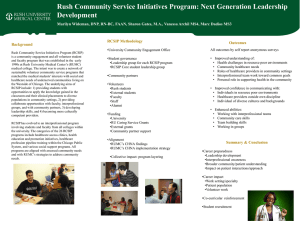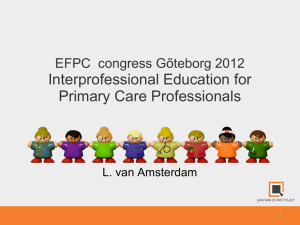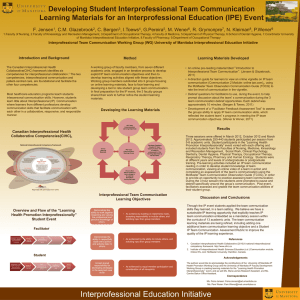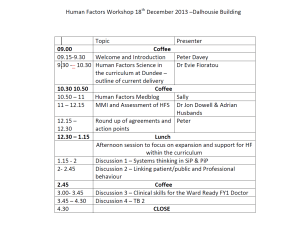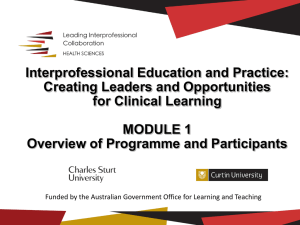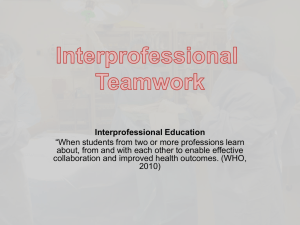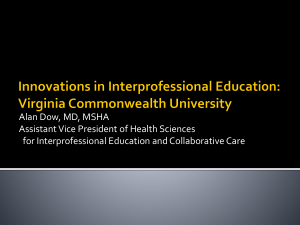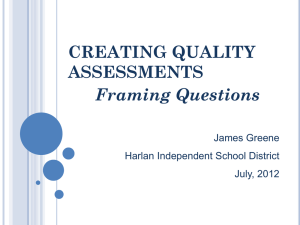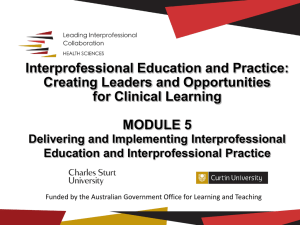Jane Morris, Chair of NAEP
advertisement
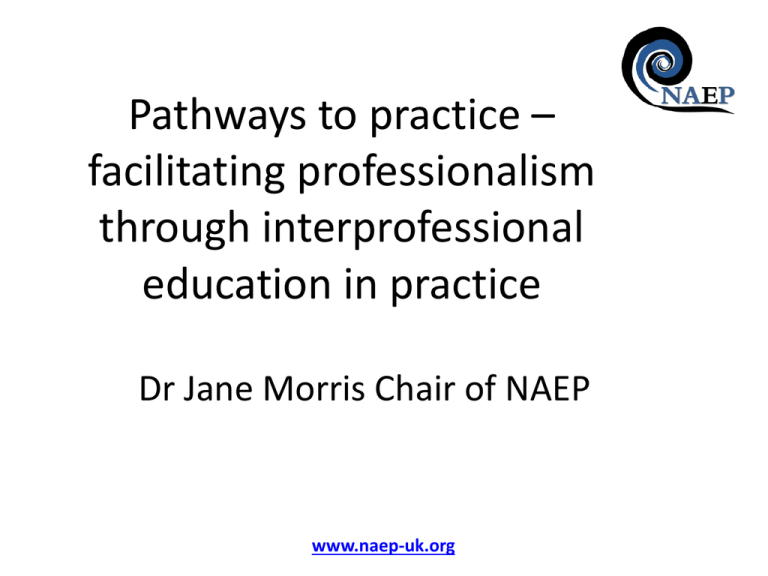
Pathways to practice – facilitating professionalism through interprofessional education in practice Dr Jane Morris Chair of NAEP www.naep-uk.org Aims of the presentation: • To identify aims and vision of National Association of Educators in Practice (NAEP) • To explore pathways to practice-making links with interprofessional education in practice National Association of Educators in Practice : purpose To support people in roles that span education and practice in health and social care and to promote the importance of such roles History of NAEP • National Lecturer Practitioner Forum 1994 • Independent group led by Professor George Castledine President in 2004 • Renamed NAEP in 2006 to reflect a more interprofessional focus • Professor Ann Moore elected chair in 2007 • Relaunched Committee formed in 2010 Vision Statements • To have a health and social care workforce in which individual practitioners fully understand the value of education for learners, patients, carers and other health care practitioners. • For high quality Practice Educators to play a key role in professional/academic development with a wide range of learners both in Health Care and in other professions with the recognition that high quality practice education inevitably leads to better patient/client care Mission Statement To ensure that professional education is grounded in practice through providing the best possible support network for educators in practice across the Health and Social Care Professions Purpose/Aims • To value and promote the importance of practice-based learning. • To support and promote the importance of all health and social care professionals who have an educational role in practice setting. • To support the development of educators in practice Objectives • Provide a structured forum that generates and delivers support to those individuals who are recorded on the NAEP database. • Provide opportunities for sharing and dissemination of good practices, collaborative working and disseminating sources of information and expertise. • Provide sources to inform the development of new roles for Educators in Practice and strategies for the advancement of education and service delivery. • Hold an Annual General Meeting to ensure that NAEP is representative of members and effectively pursues the views of members. Objectives (continued) • Maintain a live database of members. • Provide advice on policy matters. • Promote collaboration with other agencies to underpin and support Educators in Practice. • Provide and support the development of an evidence-base to underpin education in practice and ensure its dissemination to relevant stakeholders. • Promote and provide CPD opportunities leading to recognised accreditation and qualification for practice educators. How are we achieving this? • Interprofessional executive committee • building core membership • Establishing links with other organisations (CAIPE;HEA; Professional bodies; HCPC; future links with LETBS) Current NAEP activity: • New journal - International Journal of practice-based education (HEA & NAEP) • New website/newsletter/online resources • Annual conference –March 2nd 2013 • Currently exploring student membership Pathways to practice : exploring the issues Novice Autonomous professional Issues arising along the pathway: • “Not merely complex but supercomplex world of change” (Barnett,2009:12) • Focus on knowledge and skills v professional ways of becoming (D’All Alba,2008) Shaky bridge towards professional practice Challenges and constraints along the pathway to practice: Opportunities: Interprofessional Education in Practice-based settings: • Interprofessional training wards (Reeves et al,2002;2003; Mackenzie et al,2007) • Interprofessional seminars in practice (Stew,2005) • High fidelity simulation - King’s College London authentic,realistic,supportive (Hayward,2008) • Centre for Interprofessional e learning (CIPEL) IPE in practice – facilitating professional ways of becoming “Learning to become a professional involves not only what we know and can do, but also who we are (becoming)” (Dall’Alba,2008:1) IPE in practice – becoming a professional • “ we were actually working together it worked quite well to get the most out of our patients ..it’s given me more understanding of other people's roles and how other people perceive your work as well, very much so.. I now have a lot more respect for what they did and the goals we need to meet and how to work together – joint working sort of brings it together – makes it more alert” (Morris,2011) Opportunities along the pathway to practice: • Focus on practice as opposed to performance ( Beyond Competence Project 2012) • Education Outcomes Framework (Jan 2013) • New models of practice-based education • Problem-based learning in practice Role emerging placements Interprofessional role emerging placements • Physiotherapy and Occupational Therapy working with HIV patients (Solomon and Jung, 2006) • Do not have an established educator to fulfil the role • Offsite co-ordinator • Peer support, challenging, creative, assertive advocates for their roles Clarke (2012) • Occupational therapy role emerging placements • Important pedagogic opportunity to develop a deeper understanding of who they are becoming as professionals • Challenging and autonomous learning experiences – new insight and depths of understanding revealed • New ways of being as a therapist • Increased focus on ontological journey Interprofessional Education in practice future opportunities to share the wealth? Contacts NAEP President Professor Ann Moore A.P.Moore@brighton.ac.uk NAEP Chair Dr Jane Morris J.Morris@brighton.ac.uk NAEP Administrator Fran Fitch F.Fitch@brighton.ac.uk www.naep-uk.org References: • Barr, H., Helme, M.,D’ Avray, L.,(2011) Developing Interprofessional Education in health and social care courses in the United Kingdom a progress report. Occasional Paper 12. Health Sciences and Practice Subject Centre Higher Education Academy • Barnett, R. (2007), A Will To Learn. Being a Student in an Age of Uncertainty, The Open University Press. • Barnett, R. (2009), “Knowing and becoming in the higher education curriculum”, Studies in Higher Education, 34 (4), pp.429 - 440 • Dall’ Alba, G. (2009), “Learning Professional Ways of Being: Ambiguities of Becoming”, Educational Philosophy and Theory, 41, (1), pp.34-45. • Stew G. (2005), “Learning together in practice: a survey of interprofessional education in clinical settings in South-East England”. Journal of Interprofessional Care 19, pp. 223–235.



